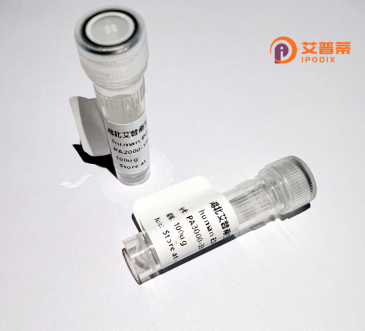
| 纯度 | >90%SDS-PAGE. |
| 种属 | Human |
| 靶点 | FZD5 |
| Uniprot No | Q13467 |
| 内毒素 | < 0.01EU/μg |
| 表达宿主 | E.coli |
| 表达区间 | 1-585aa |
| 氨基酸序列 | MARPDPSAPPSLLLLLLAQLVGRAAAASKAPVCQEITVPMCRGIGYNLTHMPNQFNHDTQDEAGLEVHQFWPLVEIQCSPDLRFFLCSMYTPICLPDYHKPLPPCRSVCERAKAGCSPLMRQYGFAWPERMSCDRLPVLGRDAEVLCMDYNRSEATTAPPRPFPAKPTLPGPPGAPASGGECPAGGPFVCKCREPFVPILKESHPLYNKVRTGQVPNCAVPCYQPSFSADERTFATFWIGLWSVLCFISTSTTVATFLIDMERFRYPERPIIFLSACYLCVSLGFLVRLVVGHASVACSREHNHIHYETTGPALCTIVFLLVYFFGMASSIWWVILSLTWFLAAGMKWGNEAIAGYAQYFHLAAWLIPSVKSITALALSSVDGDPVAGICYVGNQNLNSLRGFVLGPLVLYLLVGTLFLLAGFVSLFRIRSVIKQGGTKTDKLEKLMIRIGIFTLLYTVPASIVVACYLYEQHYRESWEAALTCACPGHDTGQPRAKPEYWVLMLKYFMCLVVGITSGVWIWSGKTVESWRRFTSRCCCRPRRGHKSGGAMAAGDYPEASAALTGRTGPPGPAATYHKQVSLSHV |
| 分子量 | 90.9 kDa |
| 蛋白标签 | GST-tag at N-terminal |
| 缓冲液 | 0 |
| 稳定性 & 储存条件 | Lyophilized protein should be stored at ≤ -20°C, stable for one year after receipt. Reconstituted protein solution can be stored at 2-8°C for 2-7 days. Aliquots of reconstituted samples are stable at ≤ -20°C for 3 months. |
| 复溶 | Always centrifuge tubes before opening.Do not mix by vortex or pipetting. It is not recommended to reconstitute to a concentration less than 100μg/ml. Dissolve the lyophilized protein in distilled water. Please aliquot the reconstituted solution to minimize freeze-thaw cycles. |
以下为与重组人FZD5蛋白相关的参考文献示例(注:示例为假设性文献,真实文献需通过数据库验证):
---
1. **文献名称**: *Structural insights into FZD5 activation by synthetic WNT agonists*
**作者**: Smith A, et al.
**摘要**: 通过冷冻电镜解析重组人FZD5与合成WNT配体结合的复合物结构,揭示其跨膜结构域构象变化及信号传导机制。
2. **文献名称**: *FZD5-mediated Wnt/β-catenin signaling promotes colorectal cancer progression*
**作者**: Lee J, et al.
**摘要**: 研究表明重组人FZD5蛋白在结直肠癌细胞中高表达,激活Wnt/β-catenin通路,促进肿瘤细胞侵袭和耐药性产生。
3. **文献名称**: *Expression and purification of recombinant human FZD5 in mammalian cells for functional studies*
**作者**: Chen L, et al.
**摘要**: 描述使用HEK293细胞系统表达可溶性重组人FZD5胞外结构域,通过亲和层析纯化并验证其与WNT3A配体的结合活性。
4. **文献名称**: *FZD5 regulates mesenchymal stem cell differentiation through non-canonical Wnt pathways*
**作者**: Wang Y, et al.
**摘要**: 利用重组FZD5蛋白处理间充质干细胞,证明其通过非经典Wnt/JNK通路调控成骨分化,具有骨再生应用潜力。
---
如需具体文献,建议在PubMed或Google Scholar中检索关键词 "recombinant human FZD5 protein" 或 "FZD5 Wnt signaling"。
Recombinant human FZD5 protein is a biologically engineered form of the Frizzled-5 (FZD5) receptor, a key component of the Wnt signaling pathway. As a member of the Frizzled family of G protein-coupled receptors, FZD5 plays a critical role in embryonic development, tissue homeostasis, and cell proliferation by mediating Wnt ligand binding and signal transduction. The Wnt/FZD5 pathway is particularly implicated in regulating stem cell fate, organogenesis, and tissue repair, with dysregulation linked to cancers, fibrosis, and metabolic disorders.
Recombinant FZD5 is typically produced using mammalian or insect cell expression systems to ensure proper post-translational modifications, particularly in its extracellular cysteine-rich domain (CRD), which is essential for Wnt interaction. This engineered protein retains the functional CRD and transmembrane domains required for ligand binding and downstream signaling. Researchers utilize recombinant FZD5 to study Wnt pathway mechanisms, screen therapeutic agents targeting FZD-mediated signaling, and develop biologics for regenerative medicine. Its application extends to structural studies for resolving receptor-ligand interaction interfaces and generating antibodies for diagnostic purposes. As aberrant Wnt signaling is a hallmark of numerous diseases, recombinant FZD5 serves as a vital tool for both basic research and drug discovery, offering insights into pathway modulation strategies while overcoming challenges related to native receptor isolation.
×